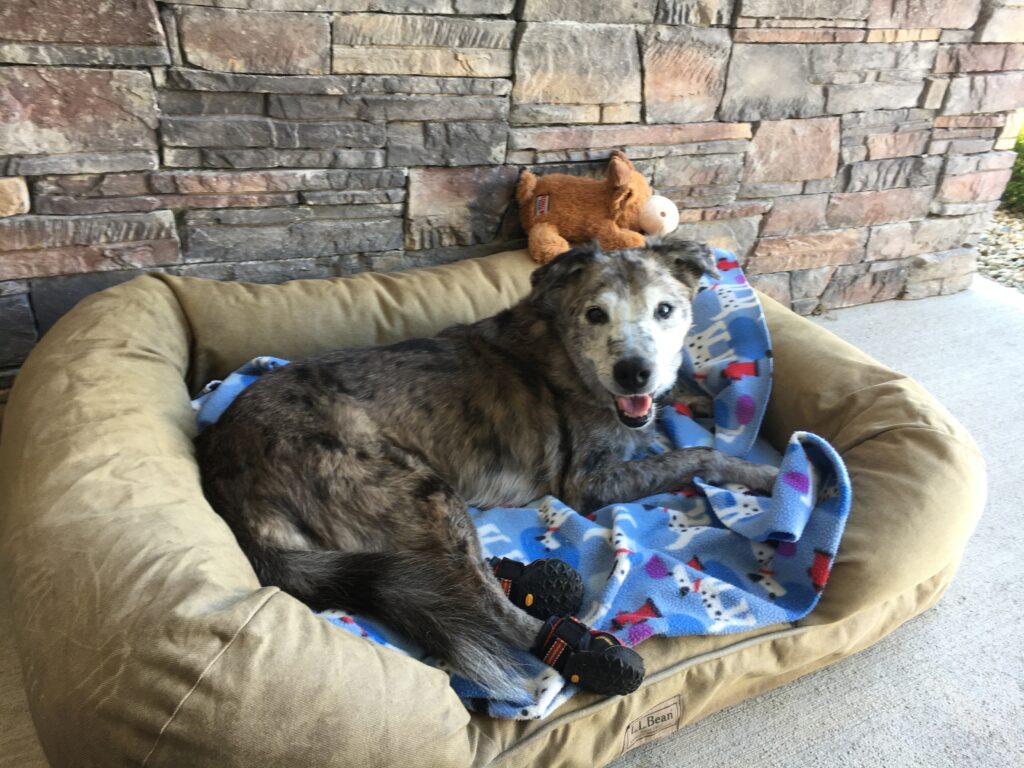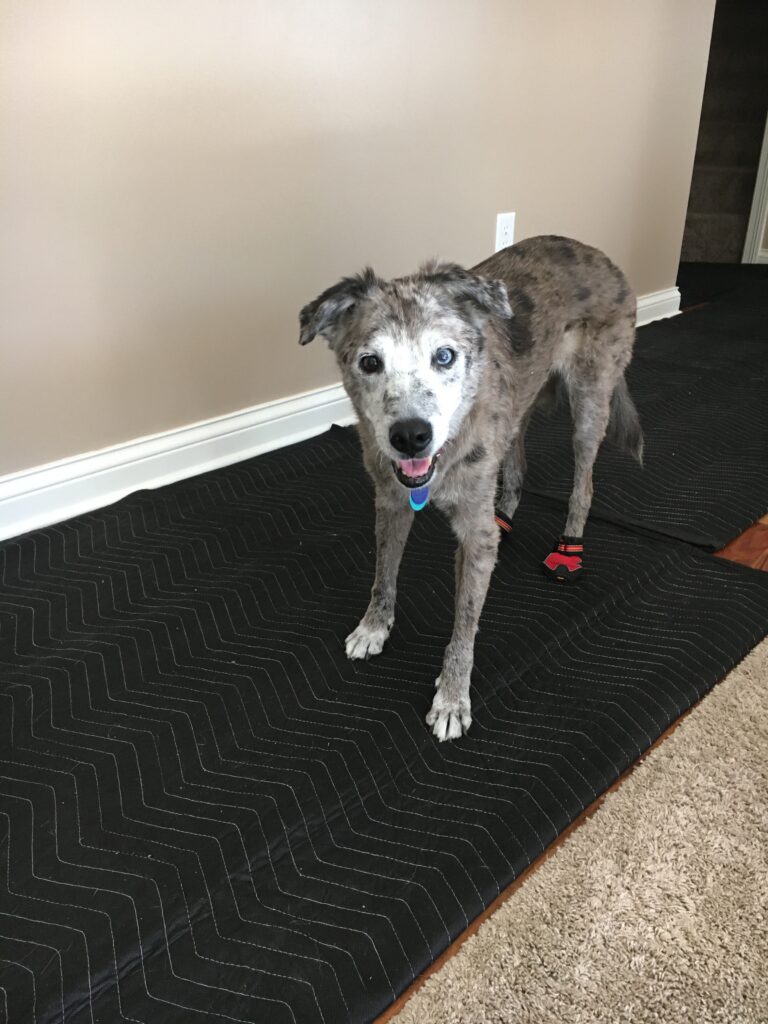Does your best friend have mobility issues? Are you noticing that she can no longer climb up on the bed or couch? Does she struggle to get up from laying down? Does she struggle to stay standing while doing her business? All these things happened to Karlie during her last few years. Although she had a degenerative disease that caused hind end weakness – Geriatric Onset Laryngeal Paralysis Polyneuropathy (GOLPP), many dogs experience these issues as they age. This doesn’t mean you have to start carrying your dog around or that she can no longer go for walks, fetch toys, or enjoy life. It just means making some adjustments.
Karlie’s hind end weakness didn’t happen all at once. It was a slow progression over year. It started with not being able to get up on the lawn chair in the backyard and then the bed, progressed to stiff legs when she first got up from laying down, and then struggling to get up or lay down. Eventually she struggled to walk a straight line since one leg was weaker than the other. At times she could not support herself when she squatted to do her business.
Keep Moving
What kind of quality of life did Karlie have and what did we do to help her get around? Karlie walked every day, she played fetch even when she struggled to walk a straight line. She went kayaking and on adventures – to beaches, garden centers, lakes, and parks. We made sure she had something to look forward to every day, even if it was just playing fetch in the yard or lounging on the porch watching the neighborhood.

One of the most important things we did was to keep her moving. Every day we took a walk – sometimes we just went down the block, other times we took a couple shorter walks. Often we walked on trails in the woods of Indiana or the canyons in California. This required walking on uneven surfaces and up and down hills. This was great physical therapy and helped maintain the strength in her back end. As things changed, we adapted when and how long we walked. We found that walking in the early morning before it got hot worked best. We purchased a cooling vest (Resources) to keep her cool on warmer days. When she struggled to walk a straight line because one leg was weaker than the other, we used a harness to support her back end, but she really didn’t like it. So we purchased a rear-wheel wheelchair. At first she didn’t want to use it on walks so we did laps in our basement to get used to it. Eventually we took her into the backyard and then out on the sidewalk of our neighborhood. Before long she was hopping up and down the curbs and taking it for two mile walks. She was our little Rockstar.
Improve Traction
In addition to the wheelchair we also purchased “sneakers” for Karlie to wear on her back feet. These helped her with traction when she was walking. We tried a variety of dog boots/shoes before we found ones that we thought worked well. The ones we purchased are from Ruff Wear (Resources). Since Karlie wore the sneakers most of the time and on long walks they started to rub off the fur on her toes so I made her some socks to wear inside the sneakers. Ruff Wear also offers dog socks to wear inside the sneakers.

Physical Therapy
In addition to walks and adventures we did physical therapy inside the house. We made an agility course in our living room which required her to walk on pillows and over dowels between 2 cones (cavaletti). We also played a lot of indoor fetch which required her to use her legs in a different way than she did on the walks. By tossing the ball to different areas and not directly to her, she had to move around. On cool days we took the game outside. We also took wanders in the yard which are just what they sound like; an opportunity for her to walk around the yard sniffing and snooping. Another thing that may help but we never tried is hydrotherapy/aquatic therapy which provides low impact walking on a water treadmill. With our first dog, Jasmine, we did something similar in our pool. I put a personal flotation device on her and supported her under her stomach while she swam.
Medicine and Supplements
The only meds that Karlie took for hind end weakness were 1/2 Carprofen and 1 Cosequin DS tablet daily. We also tried Myospet Canine Muscle formula, but did not notice any improvement with it. That’s not to say it isn’t worth trying, just that it didn’t work for us. One other thing that is important for dogs with hind end weakness is to maintain an appropriate weight. Extra weight makes it harder for dogs with mobility issues to get around. The advantage of keeping your dog moving is it’s easier to keep them at an appropriate weight.
Cover the Floors
One last thing we did to help Karlie was to put packing blankets on all the slippery non-carpeted floors. This helped with traction when walking inside the house. We used packing blankets because we had recently moved and had a large number of them. Other things that may work are area rugs, runner rugs, and yoga mats.

This is not an exhaustive list of things to do to help your dog with mobility issues, but it is what worked for Karlie. Doing these things kept Karlie with us for 14.5 years. The last nearly 2 years we battled GOLPP which slowly took away her mobility. There were periods of time when she was less mobile and then for some unknown reason would improve. We believe her willingness to try any new thing we came up with and her joy of going on adventures are the reasons she was able to overcome her mobility issues. Hopefully, some of the things we did will give you some ideas to try with your dog and help keep her moving as long as possible. We would also love to hear in the comments other ideas that have worked for you.
